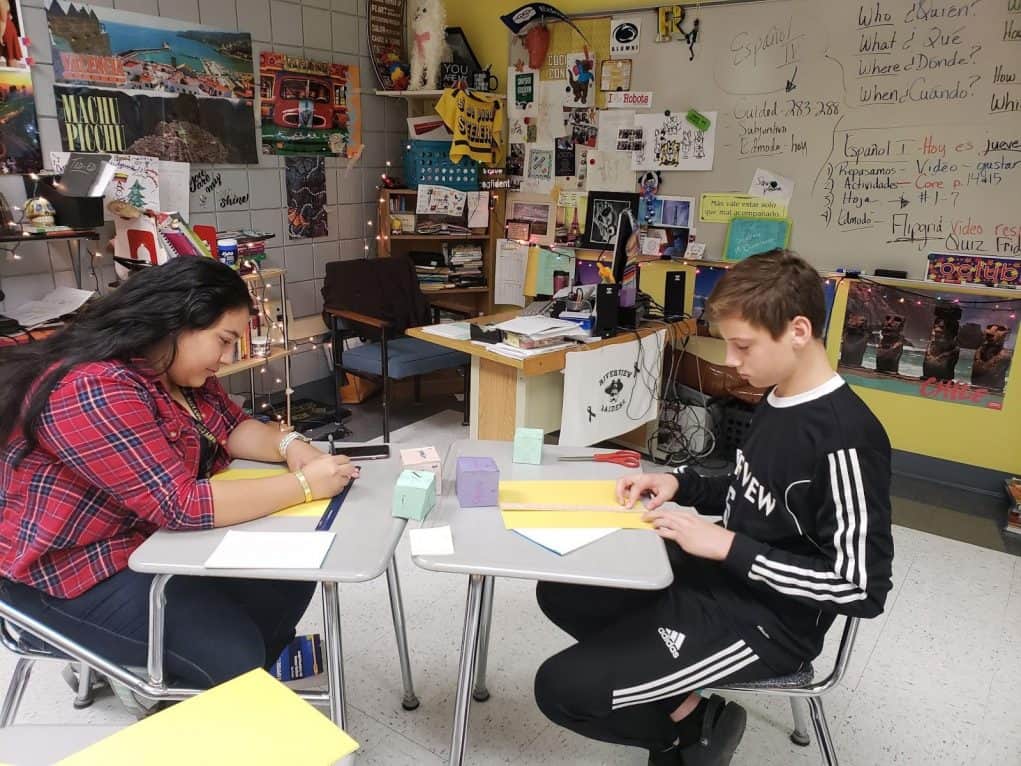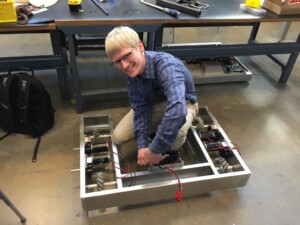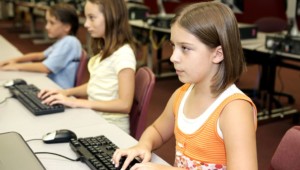Fostering High Quality Student Experiences through Projects

Over the past three years, I have been implementing Project Based Learning (PBL) in several of my classes. For years I believed that I had been doing “PBL” however after attending a conference, and reading a few books, I realized that I was not. The “PBL” was just learning based on projects, where students were doing the exact same thing, with the same end product. Although I was providing students with opportunities to collaborate and work with their peers, and choose how to show their learning, we had been focusing on the end product and moving on to the next theme, rather than focusing on the process and the learning potential involved along the way. Knowing that students needed more choices in learning and the opportunity to explore their own interests, I decided to learn all that I could about PBL and start by diving right into authentic PBL when the new school year started.
While I had been giving students more choices in “what” to create, I was not giving them opportunities to decide “what” to learn about. In order to create quality learning experiences for students, we need to go beyond simply assigning projects and instead, promote student agency by having the students drive their learning. Using the resources available from PBL Works (Buck Institute of Education) and reading Reinventing Project-Based Learning by Suzie Boss, and LAUNCH by A.J. Juliani and John Spencer, I better understood the impact of PBL on students and what PBL might look like in the classroom. I obtained a few rubrics and other resources to get started and to help the students and myself to feel more confident with PBL.
The First Two Years
There are different ways to design PBL experiences for your students, whether students independently explore the same theme, chosen by the teacher, or students have more control and determine their own PBL focus. By doing this, we can create higher quality learning experiences for our students, which promote student agency and empower students to drive their learning.
In my Spanish III and IV classes, I decided to have students decide on a theme, craft an essential question, and to work on their PBL over the course of anywhere from nine to twelve weeks, roughly one grading period. There were some challenges during the first two years, ranging from accountability and students staying on track, to students not ready to present their work, and a few times, students struggled with deciding what to explore. For many years in school, students have become used to being told what to create that when given an opportunity to make their own decisions, I’ve seen students struggle a lot with this independence. Students want to focus on the product first. An analogy that I’ve used often is to imagine going to a card shop and finding the perfect gift bag or packaging before buying the gift. What happens when the gift you buy cannot fit into that package? I tell students not to think about the end result but to think about all of the steps along the way. I do believe it will become clearer to students as they continue to explore, question, and reflect on their learning.
In the second year, I wanted to go beyond simply having students learn about issues related to the Spanish culture or language, and to explore on a global scale, even connecting with other classrooms and students around the world. I wanted them to build connections, experience more authentic learning by communicating and collaborating with students from Spanish speaking countries. We know that using technology simply to use it is not purposeful. But when we leverage technology to connect our students with real-world learning experiences, beyond the walls of our classroom and even our community, it takes learning to a whole new level. We can provide more personalized and authentic learning for students, that will attach more meaning to what they are doing and why it matters.
More than Projects: High-Quality Student-Centered Learning through PBL
Entering our third year of project-based learning, I wanted to go beyond what we had already done and push the limits somehow. We had accomplished a lot in the first two years, becoming more comfortable with PBL and then connecting globally using tools like Edmodo and Flipgrid. As educators, we should encourage and inspire our students to take their learning in a different direction or to take one more step and explore on their own. We need to engage students in learning which is purposeful, relevant and authentic, by leading them to explore and connect with real-world issues.
Students became deeply invested in their work when we started to focus on the Global Goals and “Teach SDGs.” I believed that by having students focus on one or two of these global goals, and connecting the goals to the work that they were doing would be beneficial for them. They would become more culturally aware and broaden their global understanding. My goal was to work toward designing high-quality PBL (HQPBL) in my classroom in year three. To do so, I explored the six criteria of the framework for designing HQPBL and I decided to use these criteria as points of focus to create better and higher quality learning experiences for my students.
Student Experiences through PBL
1) Intellectual Challenge and Accomplishment: Students learn deeply, think critically, and strive for excellence. In deciding upon topics for PBL, the students brainstormed ideas together, drawing on content from other courses and personal interests. The issues that students were most passionate about included gender equality, poverty, health and wellbeing, equity, and quality education. They selected topics that went far beyond their prior focus areas of holidays, customs, family life, and similar themes traditionally covered in their Spanish course. Students were curious, asked a lot questions and collaborated to offer solutions to problems they had identified.
2) Authenticity: Students work on projects that are meaningful and relevant to their culture, their lives, and their future. As students in grades 10 through 12, many are thinking about their future and decide to explore topics related to what they hope to do after high school and even later on in life. Students explored topics that required them to interact more with their peers and also to connect with students and teachers from Spain and Argentina. By sharing the conversations they had, made possible through tools like Flipgrid and Synth, students became more connected with what they were learning, even commenting on how much they had learned from one another. Students reflected on their work and often mentioned that because of the PBL experience, they had stopped worrying about grades and only cared about what they were going to learn next. By having control and engaging in meaningful and relevant work, students experienced more powerful and authentic learning.
3) Public Products: Students’ work is publicly displayed, discussed, and critiqued. Presenting to one’s classmates can be scary, but we need to create opportunities for students to share their work and to do so beyond the classroom walls. We had used several tools to facilitate the exchange of information with the schools in Spain and Argentina, and at first, some students were hesitant to interact and lacked confidence in sharing their work. Students first shared their work on a global scale by using Padlet, which created new and authentic learning opportunities that were more than what I could possibly offer them by myself. While it can be a risk to create and share with others, especially people who you do not know well, and possibly cannot interact with, it is an important part of the learning process that will better prepare students for the future. Displaying work enables students to be a part of the important process of feedback and learning how to reflect, revise and set new learning goals.
4) Collaboration: Students collaborate with other students in person or online and/or receive guidance from adult mentors and experts. Technology enabled students to connect, beyond what I had initially hoped for in year one. Students in Spanish IV had been posting messages to their global peers, asking questions about school, traditions, travel and decided to create a trip for the students from Argentina and Spain to come and visit Pittsburgh. The students took the lead and using Google Slides, planned a trip, with each student having a specific, self-designated role in the process. Once the slides were ready, they used the Chrome extension to transfer it into an interactive Nearpod lesson to “assign” to the other students. The Spanish IV students were excited to review the responses, and to then receive a Nearpod lesson that students and teacher in Argentina had created for them. Through this experience, they not only learned about one another, but they had a more interactive way to more deeply understand different cultures and experiences.

5) Project Management: Students use a project management process that enables them to proceed effectively from project initiation to completion. Students have many opportunities to work in groups throughout school. Sometimes the work is not evenly divided, which can happen and is a good lesson for learning how to communicate and collaborate within a group. Sometimes it also involves speaking up in the group, to make changes that are needed and to keep everyone involved and working together. Knowing that they wanted to create a trip to Pittsburgh, students spent a few days trying to decide upon the best way to work together on the same project. It took a bit of brainstorming and even some minor disagreements. To give them the most authentic experience, I did not step in to help in this phase. Instead, I wanted students to figure it out on their own, to decide the roles of each group member, to collaborate, and to sometimes disagree because these are the types of experiences they will likely encounter in the future. Being able to work through the project, check on one another’s progress, give reminders and have defined roles led to a more unique learning experience.
6) Reflection: Students reflect on their work and their learning throughout the project. It is always important to look back over the work that has been done and think about the process involved. One of the most important considerations is to provide a comfortable space where students feel comfortable reflecting and sharing, of offering feedback to their peers and using it to determine their next steps. Students took time to evaluate their efforts, the steps they had taken if there were any challenges and how they could better prepare. Reflecting means asking oneself whether anything could be done better, which the answer should always be yes. It is important for students to develop the skills to self-assess, be open to receiving feedback and also learning how to use that feedback to set new personal learning goals. Continuing to work on building peer relationships is crucial to this component and when students become more comfortable with peers, they will also build their confidence in the learning process.
Reasons for Designing PBL
As educators, we need to provide more authentic ways for students to learn and to drive their learning. Using methods like Project Based Learning or Design Thinking will afford the best opportunities for students to be prepared for the future. We cannot predict the type of work students will choose and what skills those jobs might demand, but we can help students to develop skills which will be applicable to many areas of work and life.
By designing PBL experiences, and working toward HQPBL, students can experience unique, authentic and meaningful ways to explore real-world issues, experience productive struggle as they work through challenges, know how to find and evaluate the right resources, move away from a focus on an end product and work together. We want to guide students on a learning journey, where they have control and can ask questions, design their own problems to solve and develop a growth mindset. Students need opportunities to become the drivers of their learning.
For more, see:
- New School Formula: Harder Problems and Fewer Answers
- Helping Students Prepare for Their Futures with Linkedin
- Cultivating An Innovation Mindset in the Classroom
Stay in-the-know with innovations in learning by signing up for the weekly Smart Update.








Saddam
Thanks for sharing this information
Best Training institute: http://digication.in
Suraj
Thanks for this amazing information.